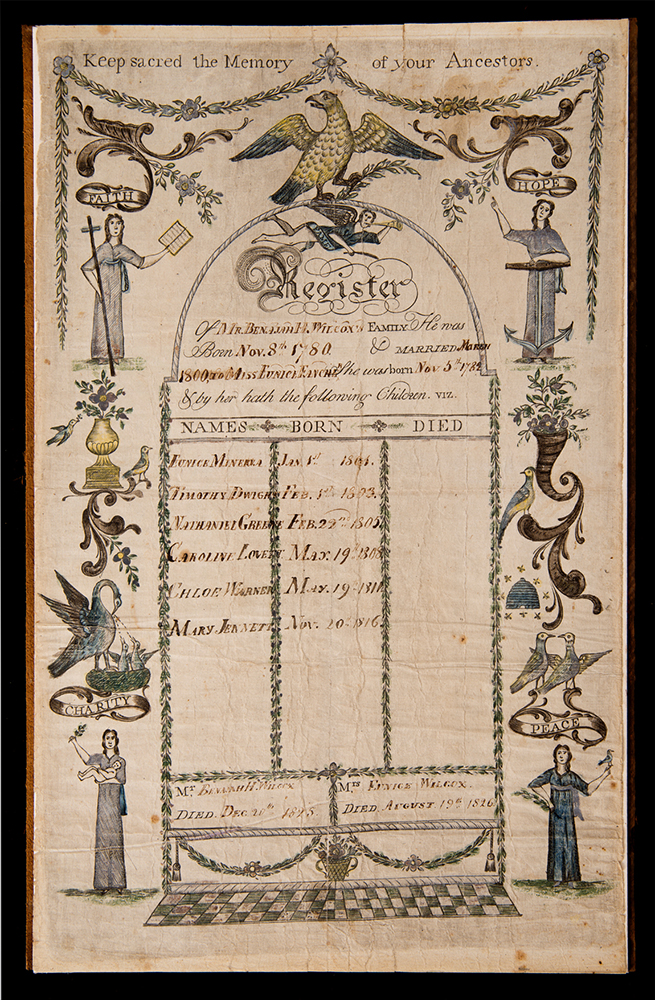
Deborah M. Child
Deborah M. Child is a New Hampshire author, lecturer and independent curator. After working in academia, the museum field and the auction business, her focus is now researching and writing about folk artists. Her newest book, Soldier, Engraver, Forger: Richard Brunton’s Life on the Fringe in America’s New Republic, was published by New England Historic Genealogical Society (Boston) in April.
How did you get interested in the story of Richard Brunton?
In 2013, while I was searching for more information on another artist who spent time inside the Massachusetts State Prison in Charlestown, an image was e-mailed to me of a family register inscribed: “The whole of this record on the other side was made with a pen by a convict in the Charleston [sic] state prison, Mass.” As it had all the hallmarks of the hand of Brunton, I quickly checked the prison register for his name and from there the idea for writing a book on Brunton rapidly unfolded.

Attributed to Richard Brunton (1749–1832) is this family register of Benajah Humphrey Wilcox and Eunice Fancher, circa 1800. The hand colored line engraving, measuring 14 by 9 inches, private collection, is one of Brunton’s larger-format family registers and a rare survivor. Photography by Michael Fredericks
He has been alternately praised for his primitive yet charming family registers and vilified as a “degenerative convict.” How will the historical record remember him?
I strongly believe that as scholars take the time to study his works more closely, he will be seen as less of a “degenerative convict” and appreciate him more for the enterprising individual he was and the bookplates, family registers, engraved portraits and medallions he created which provide such an intimate glimpse into the trying times in which he lived.
Why do you think he was so fascinated with birds, using them as a frequent motif in his work? Is there an autobiographical hidden meaning here?
Birds — pelicans, eagles, sparrows, robins — are a signature feature throughout Brunton’s oeuvre. They animate his designs and draw in the viewer. Given his reported lameness cited in court records and his imprisonment on at least three occasions, I often wonder whether he envied their ability to take flight.
Tell us about some of the paradoxes in his life.
Brunton fought in some of the bloodiest battles of the American Revolution, yet many of his engraved family registers bear the names of descendants of those he fought against. He created poignant tokens that imply a reverence for love and family, yet he spent most of his life without home or family. Although a master at making counterfeit money, he failed to accumulate any trappings of wealth and died a pauper. He created many artifacts with names of individuals and families and yet he left few traces of his own existence. Only four of his engravings bear his full surname. The remainder are initialed “RB,” bear the monograph “RB” or lack markings altogether.
Looking at examples of his work, he had talent. Why was he unable to make an honest living at his craft and what caused him to turn to counterfeiting?
In the midst of the Revolutionary War and in its aftermath, many New England craftsmen were struggling to make a living. Few citizens had money to purchase anything beyond the bare necessities. Raw materials required for the trades were in equally short supply. Like many a trained engraver caught in a pinch, the temptation to make counterfeit money proved to be just too great for him. His story is perhaps better known than most because of his impressive engraving of New-Gate Prison and the portraits of the keeper and his wife, now at the Connecticut Historical Society, that he executed during his two-year sentence stint there for counterfeiting.
How does this book tie into other projects you are currently working on?
Brunton is the third and earliest artist that I have studied who painted portraits inside prison and who was incarcerated for counterfeiting currency. My research on two others — the Wilkinson limner (see Expressions of Innocence and Eloquence: Selections from the Jane Katcher Collection of Americana, Vol. II, 2011, 141–153) and Samuel Jordan (b Boston, circa 1804) who painted portraits while inside the Massachusetts State Prison in the 1820s — is also still ongoing. It is my hope that plans for a traveling exhibition which will feature the work of these three artists and their contemporaries will soon be formalized.
Read article and see more images inside July 17, 2015 E-edition

